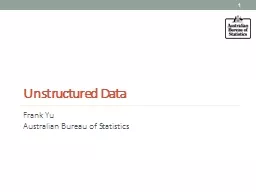

Frank Yu Australian Bureau of Statistics Unstructured Data 1 What I will cover in this talk What unstructured data is and its value for official statistics The challenges that it presents statistical production ID: 772638
Download Presentation The PPT/PDF document "Frank Yu Australian Bureau of Statistics" is the property of its rightful owner. Permission is granted to download and print the materials on this web site for personal, non-commercial use only, and to display it on your personal computer provided you do not modify the materials and that you retain all copyright notices contained in the materials. By downloading content from our website, you accept the terms of this agreement.
Frank YuAustralian Bureau of Statistics Unstructured Data 1
What I will cover in this talk What unstructured data is and its value for official statisticsThe challenges that it presents statistical production What the ABS is doing to progress capability in this area 2
Features of “unstructured” data Does not reside in traditional databases and data warehouses May have an internal structure, but does not fit a relational data model Generated by both humans and machines T extual and multimedia contentMachine-to-machine communicationExamples includePersonal messaging – email, instant messages, tweets, chatBusiness documents – business reports, presentations, survey responsesWeb content – web pages, blogs, wikis, audio files, photos, videosSensor output – satellite imagery, geolocation data, scanner transactions 3
The value of unstructured data sources Provide a rich source of information about people, households and economies May enable the more accurate and timely measurement of a range of demographic, social, economic and environmental phenomenaCombined with traditional data sourcesAs a replacement for traditional data sources So presents unprecedented opportunities for official statistics toImprove delivery of current statistical outputs Create new information products not possible with traditional data sourcesABS believes that the benefit should be demonstrated on a case-by-case basis – the improvement of end-to-end statistical outcomes in terms of objective criteria such as accuracy, relevance, consistency, interpretability, timeliness, and cost 4
Content analysis For unstructured data to be useful it must be analysed to extract and expose the information it contains Different types of analysis are possible, such as: Entity analysis – people , organisations, objects and events, and the relationships between them Topic analysis – topics or themes, and their relative importanceSentiment analysis – subjective view of a person to a particular topicFeature analysis – inherent characteristics that are significant for a particular analytical perspective (e.g. land coverage in satellite imagery)Many othersTechniques and tools already exist or being developed … 5
But the scale is mind-boggling 6 1 ZB = 10 21 bytes = 1024 Exabytes About 85% is unstructured data
Big Data Data sets of such size, complexity and volatility that their business value cannot be fully realised with existing data capture, storage, processing, analysis and management capabilities 7 The systematic use of unstructured data is a Big Data challenge!
Some other significant challenges Validity of statistical inference Sample biases Model biases Privacy and public trust Disclosure threat due to mosaic effect Data integrityMissing, inconsistent and inaccurate dataVolatile sourcesData ownership and accessPublic good versus commercial advantageValue of private sector data 8
ABS work in this area Established an research program led by Methodology Division to build a sound foundation for the mainstream use of Big Data – particularly unstructured data – in statistical production and analysis Investigating techniques and technology solutions for future enterprise systems – such as open-source, NSI-source, and commercial software productsParticular areas of interestMachine learningMultidimensional data visualisationSemantic Web methodsDistributed computing 9
Some key initiatives for 2013-14 Satellite imagery for agricultural statistics – use of satellite sensor data for the production of agricultural statistics such as land use, crop type and crop yield. Mobile device location data for population mobility – use of mobile device location-based services and/or global positioning for measuring population mobility Visualisation for exploratory data analysis – advanced visualisation techniques for the exploratory analysis of structured and unstructured data sets Automated entity analysis of unstructured data –techniques for the extraction and resolution of concepts, entities and facts from text data 10
Questions? 11